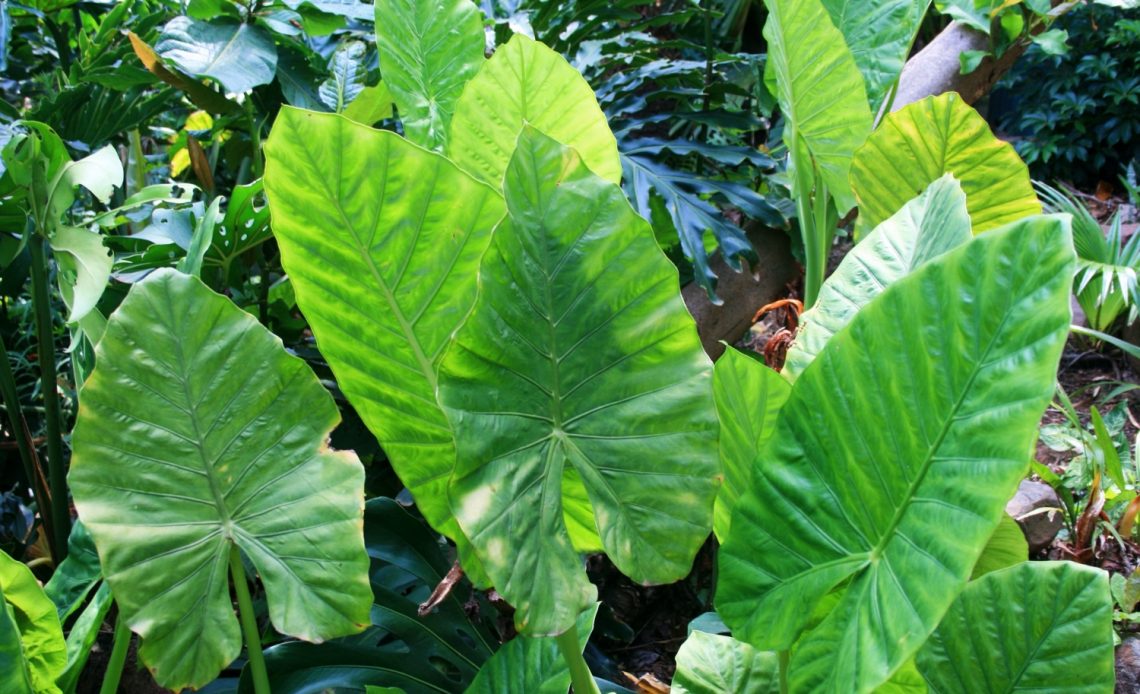

We’re here to help! Wild Yards is a completely free website that is 100% dedicated to helping you create a wildlife-friendly, sustainable yard. Read more
WildYards is reader-supported. When you buy a product through a link on our site, we may earn a comission. Every product is independently selected by our (obsessive) editors and our reviews are unbiased and objective. Read more about our mission or our privacy policy.
Elephant ears are a group of sub-tropical plants known for their massive triangle-shaped leaves.
These plants are perfect for adding a touch of greenery to your Japanese-inspired zen garden, or for creating a space with a tropical feel.
In general, elephant ears are easy to grow. As long as you meet their growing requirements, they can grow rapidly.
If you’ve noticed your elephant ear plant drooping lately, you’re probably wondering what’s going on, and if you should be concerned
Here are 13 reasons why elephant ears can wilt and go limp, plus solutions that will help the plants recover.
Improper watering and failing to meet your elephant ear’s light requirements can result in drooping. Because elephant ears are heavy feeders, low nitrogen can contribute to drooping as well.
1. The problem: Overwatering
Your elephant ears will grow best in loose, loamy soil that is rich in organic materials, but that also drains well.
Elephant ears are a sub-tropical plant, so they’re naturally going to perform best in conditions that mimic those of the jungle floor, which is rich in decaying materials and retains some moisture.
But, much as elephant ears need to stay moist, they can still suffer if they receive too much water.
When the soil becomes waterlogged, air can no longer reach the plant’s roots. The resulting root rot leads to yellowing foliage, leaf blisters, and drooping.
If your elephant ear is starting to wilt, take a look at the soil.
If you see water standing, or if the soil feels wet an inch beneath the surface, and has been wet for more than a few days, those are good signs the plants are struggling to breathe.
The solution: Let the plants dry out
If your elephant ears have been overwatered, then the answer to the problem is simple. Just scale back on your watering schedule and give the plants a chance to dry out.
When planted in soil that has been amended with moisture-retaining materials, like compost, manure, and sphagnum moss, elephant ears need enough water to keep the materials damp.
These materials act like a sponge which the elephant ears can draw water from as they need it.
A good rule of thumb is to give your elephant ears an inch of water per week, more in hot, dry weather, and less in cool, humid weather.
Another important measure you may need to take is improving drainage.
Amend loamy, compacted soils with sand or perlite to keep them airy and porous, and be sure to plant your elephant ears where they won’t be sitting in puddles for days after it rains.
Once you’ve given your elephant ears a chance to dry out, the plants should recover within a few days.
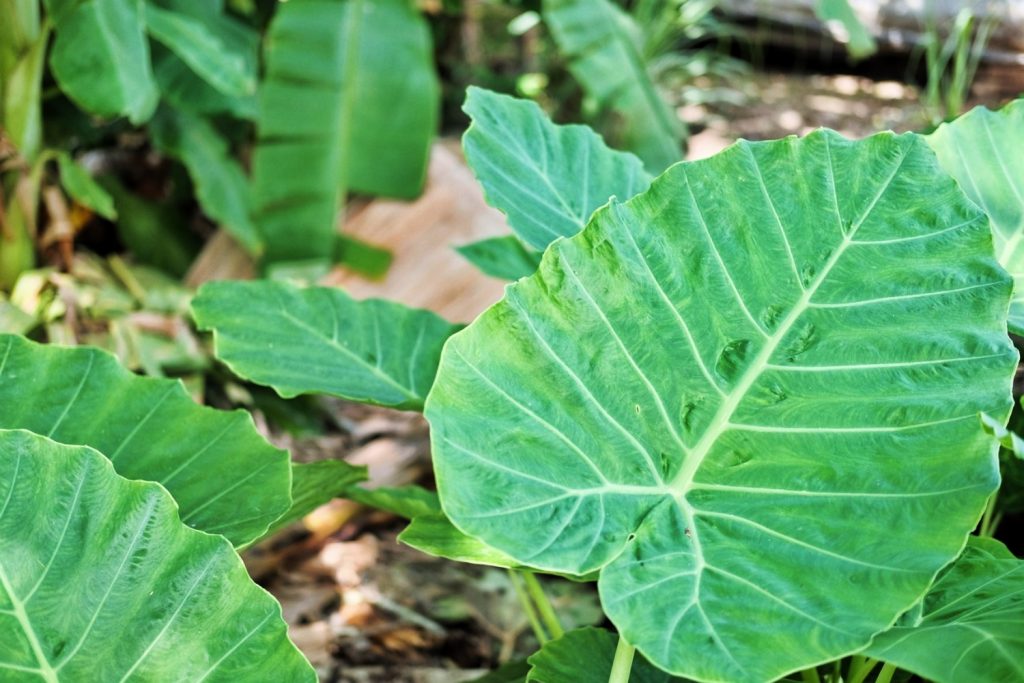
2. The problem: Underwatering
When elephant ears don’t get enough water, this can spell trouble for the plants, too.
When water is in short supply, the plants will soon start to droop. In extreme cases, the plant may turn yellow and brown and drop leaves.
You’ll need to check the soil to determine whether or not your elephant ears are too dry.
If the soil feels powdery at a depth of one inch, then it is much too dry for your elephant ear’s liking.
Remember, elephant ears prefer to grow in humusy soil that stays consistently moist.
Because these plants can also suffer from overwatering, this means you’ll have to walk a fine line to keep them satisfied.
The solution: Turn on the hose
If your elephant ear’s soil dries out too much, then the plant will start to suffer. Fortunately, the solution to this problem is easy.
Just give the plant a drink!
Water your elephant ear plants deeply to encourage strong roots. And keep an eye on the soil to make sure it stays moist enough for your elephant ear’s liking.
If your elephant ear’s soil is somewhat sandy, you may need to amend it with organic materials so it can retain more moisture.
You can also use mulch to prevent your elephant ears from drying out too much.
Growing the elephant ears with the appropriate companions also works to their advantage by enabling them to trap humidity. This, in turn, helps seal moisture into the soil.
3. The problem: Insufficient sunlight
Insufficient sunlight can also cause your elephant ears to droop.
Like any other plant, elephant ears utilize a process called photosynthesis to produce food for themselves.
If the plants don’t receive enough sunlight, then they won’t be able to turn the water, nutrients, and carbon dioxide they absorb into energy.
In the short term, plants may begin to droop. But after a few weeks of growing in insufficient sunlight, your elephant ear’s foliage will turn yellow.
If your elephant ears are in full shade, or if they only get 4 hours of sunlight a day, then their light requirements are not being met.
The solution: Transplant the elephant ears to a sunnier spot
Elephant ears aren’t like succulents and cacti. They can’t tolerate dry soils and full sunlight.
That said, they do still require enough light to meet their energy demands.
If you find that your elephant ears aren’t getting enough sunlight, move them to a brighter location.
Transplant plants to a spot where they can receive indirect sunlight all day, or morning sunlight and afternoon shade.
Situate potted plants on the east side of your home to help them catch the morning sun and recover from their energy deficiency.
Giving your elephant ears more sunlight will improve their appearance dramatically within just a few days.
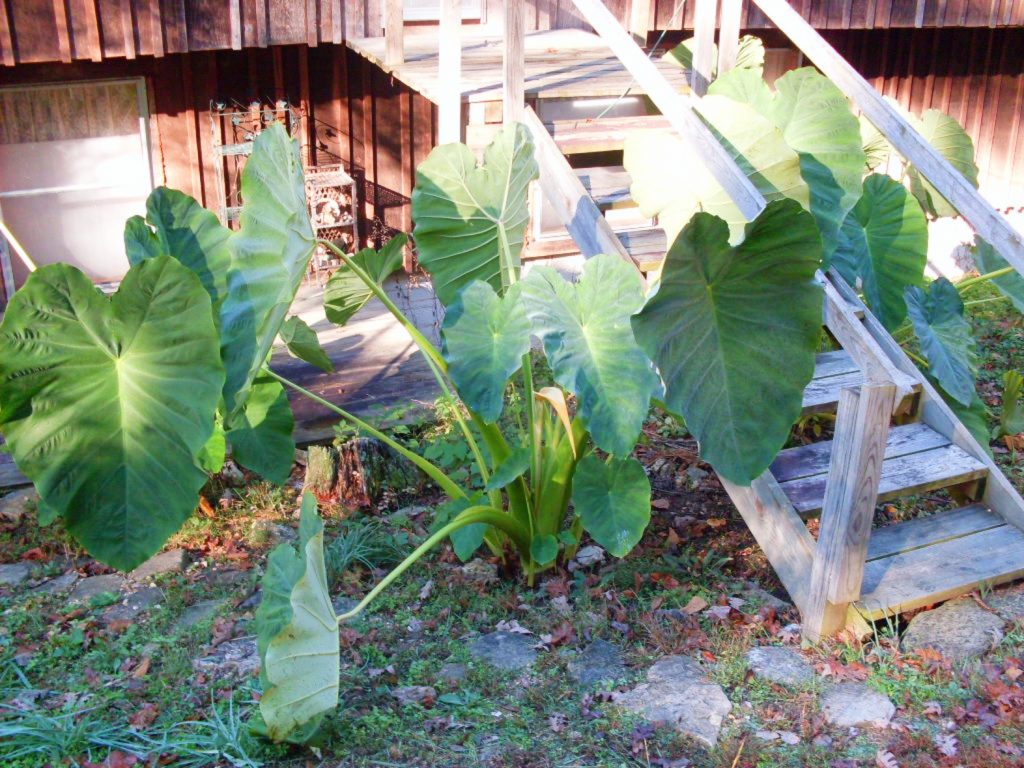
4. The problem: Too much sunlight
If your elephant ears are drooping, and you’re certain that it’s not because it’s being over-watered or under-watered, then the next thing you should examine is how much sunlight the plant is getting.
Elephant ears grow best when planted in bright, indirect sunlight. This allows the plants to get all of the light they need for photosynthesis.
It also keeps the plants warm without letting them get too hot.
If your elephant ears are getting too much sun, they may begin to droop.
You’ll also likely notice yellowing foliage, which may turn brown despite regular watering.
Keep an eye on your elephant ear during the day to see how much sunlight it’s getting. If the plant is receiving more than 4 hours of direct sunlight per day, then it may be getting too much light.
The solution: Move the plants to a shadier location
If your elephant ears are getting more sunlight than they need, then you must move them to a shadier location.
Ideally, your elephant ears should be planted in a location where they can receive plenty of indirect sunlight.
In the absence of such conditions, planting your elephant ears in a location where they receive morning sun and afternoon shade should suffice.
Move potted plants onto your porch, deck, or patio to shield them from the sun’s scorching rays.
You can also try planting your elephant ears around a large tree to give them some protection. This mimics the conditions of their native environment, and will also help keep their soil moist and cool.
5. The problem: Low humidity
Some plants, like rosemary and lavender, rely on good ventilation to prevent diseases like powdery mildew from setting in.
But elephant ears dislike growing in well-ventilated areas. Instead, these plants thrive when kept in somewhat humid spaces.
If the air is too dry for your elephant ears, then they’ll let you know by wilting.
You’ll also notice their foliage getting slightly wrinkled and tissue-paper-like. That’s because the air around them isn’t moist enough to keep their leaves adequately hydrated.
When humidity is low, elephant ears may also turn black or brown. In severe cases, the plants may lose their leaves and die.
If your elephant ear has been growing more slowly lately, that’s another sign that the atmosphere isn’t staying damp enough for the plant to grow healthily.
The solution: Keep the air moist
Spray potted and indoor plants with water to ensure their leaves stay hydrated.
When watering outdoor elephant ears, be sure to sprinkle the foliage with water.
You can also make conditions more humid for your elephant ears by creating a makeshift greenhouse around them.
Arrange stakes around the plants, and cover them in clear plastic or mesh fabric, leaving 6 to 12 inches at the base of the plant to allow for some ventilation.
This method works well for helping plants recover from dry conditions. However, this is not a long-term solution.
Leaving your elephant ears in such a damp environment over a long period can be equally dangerous, and may also result in drooping due to…
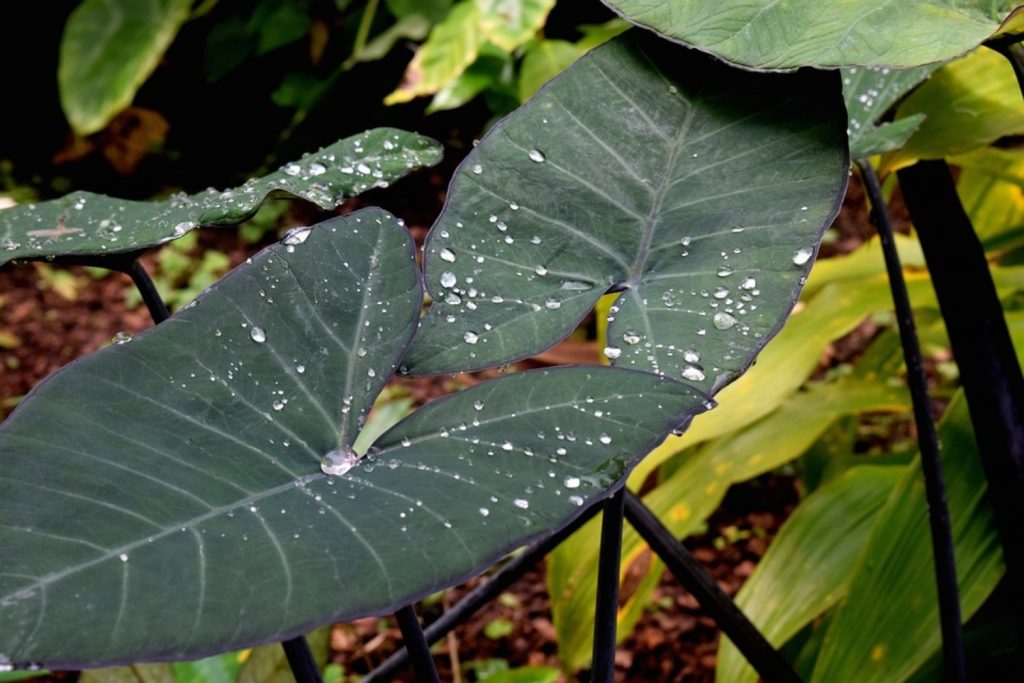
6. The problem: Fungal infections
Keeping your elephant ears in a humid environment is essential. Unfortunately, it’s also a double-edged sword.
Excessive moisture sets your elephant ears up for a fungal infection.
While it’s important to keep elephant ears adequately hydrated, and their foliage damp, keeping the plants overly moist enables spores to spread.
Fungal leaf blight is the most common infection elephant ears suffer from.
If your elephant ear plants are drooping, this could be the reason why. Fungal leaf blight results in wilting foliage and even collapse.
Bacterial soft rot and stem rot are also fairly common. These pathogens are highly destructive and lead to drooping and structure loss.
Once plants show symptoms of bacterial soft rot and stem rot, their health is already so compromised that they are most likely beyond saving.
The solution: Remove diseased foliage and apply a fungicide
Diseased elephant ears should be treated quickly to halt the infection and prevent it from spreading to surrounding plants.
Use pruning shears to remove infected foliage, being sure to spray the clippers down with a bleach dilution in between each cut, to avoid spreading the infection to healthy parts of the plant.
Once the plant has been pruned, apply a copper-based fungicide.
Avoid watering the plant from the top down, and keep the leaves on the drier side. While the leaves should still be kept moist enough that they don’t wilt and wrinkle, don’t apply so much water that it pools on the plant’s foliage.
Taking these measures will help the elephant ear plants regain their footing and get back to producing healthy leaves.
As for bacterial soft rot and stem rot, your best bet is to remove infected plants immediately to avoid spreading the disease to surrounding plants.
7. The problem: Nitrogen deficiency
Elephant ears are known for their gigantic and distinctive leaves. But for the plants to produce their iconic foliage, they need plenty of nitrogen at their disposal.
Nitrogen deficiency is another common cause of elephant ear plants drooping.
Other signs of this nutritional deficiency in elephant ears include stunted growth, yellow and brown foliage, discolorations, and dieback.
If you suspect your elephant ears are struggling with low levels of nitrogen, then use a soil test to determine if levels are really low.
The solution: Apply a nitrogen-rich fertilizer
Because they produce so much foliage, elephant ears have an increased need for nitrogen, specifically.
Nitrogen is considered to be the most important nutrient for plants. This element is a key component of chlorophyll, which plays a role in photosynthesis.
Without nitrogen, elephant ears droop, turn yellow, and stop growing.
It’s important to feed elephant ears high-nitrogen fertilizers like feather meal and blood meal to make sure they get plenty of nitrogen.
Although synthetic fertilizers like 30-0-10 may work best for feeding elephant ears that are struggling with a severe nitrogen deficiency, organic fertilizers are often the better choice.
Organic fertilizers support soil health, which, in turn, supports plant health.
Add nitrogen-rich soil amendments to your elephant ear’s substrate at the start of the growing season, and throughout the growing season, to keep them healthy and happy.
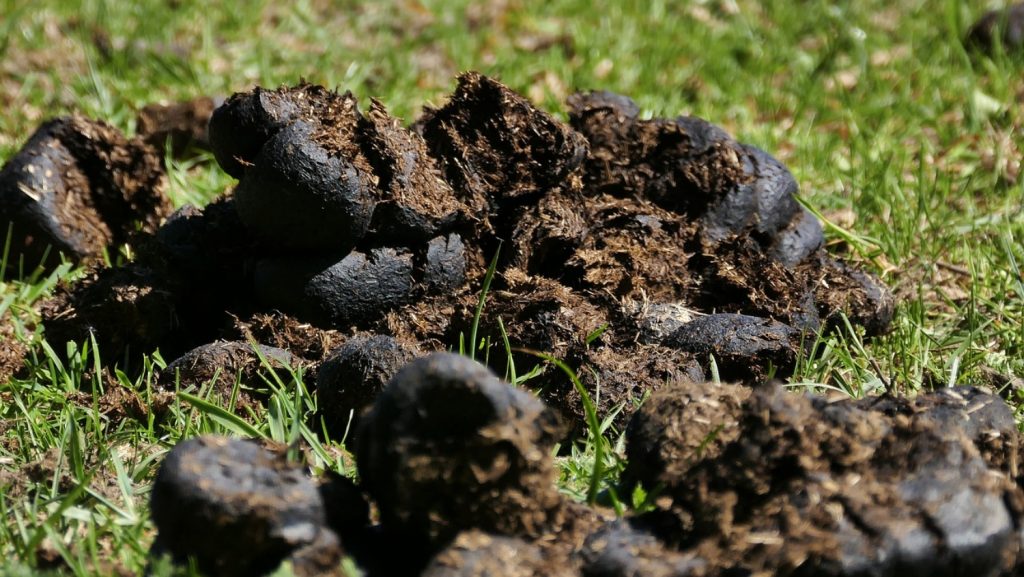
8. The problem: Other nutritional deficiencies
Of course, it’s also possible that your elephant ears are struggling with another nutrient deficiency.
Elephant ears rely on phosphorus and potassium to replicate their genetic materials to produce new tissues and regulate moisture intake.
Trace minerals like iron, manganese, and sulfur also play an important role.
Without these minerals, your elephant ear plants will be unable to perform many of their basic metabolic processes, including photosynthesis and respiration.
If they can’t function properly, then the plants will no longer be able to produce an adequate supply of energy from themselves, resulting in drooping, sad-looking leaves.
Use a soil test to determine which nutrients your elephant ear plants are lacking.
The solution: Feed the plants more often
Because elephant ears rely on so many different nutrients, it’s best to use a variety of organic fertilizers to feed them.
Kelp meal is a great source of iodine, copper, and zinc that your elephant ears will benefit from.
Epsom salts can help revitalize wilting, yellowing foliage by giving the plants an extra dose of magnesium.
And, of course, compost is an excellent addition to the soil, not only because it’s a rich source of nutrients, but also because it adds structure to the substrate, keeping it loose and promoting good drainage.
These organic materials are ideal fertilizers because they release slowly, keeping the soil fertile and nutritious for much longer than synthetic plant foods.
9. The problem: Over-fertilization
Another good reason to test your soil before applying fertilizer is to avoid applying too much of it.
Applying too much of one nutrient and not enough of another creates imbalances in the soil that can lead to drooping, yellowing foliage, foliage burn, and even the death of the plant.
Feeding your plants too often can also be a problem.
Although elephant ears are heavy feeders, even they can be over-fertilized.
Not only does over-fertilizing your plants contribute to nutritional imbalances, but it can also make plants more prone to diseases and insect infestations.
That’s because nutritional imbalances lead to nutritional deficiencies, and when plants don’t have all of the nutrients they need to support a healthy immune system, their resistance to pests and infections inevitably declines.
The solution: Stick to a fertilizing schedule
Consider the soil your elephant ears are growing in.
Native soils that are sandy and have been amended with organic materials will need to be fertilized regularly because their supply of valuable nutrients is limited.
But soils that are already nutrient-dense and full of decomposing organic matter are a good source of nutrients on their own.
Plants growing in humusy, rich soils are at a higher risk of being overfed.
So to avoid over-fertilizing your elephant ears, test your soil periodically, and stick to a strict fertilizing schedule. That way, your plants won’t develop nutritional issues or drooping foliage.
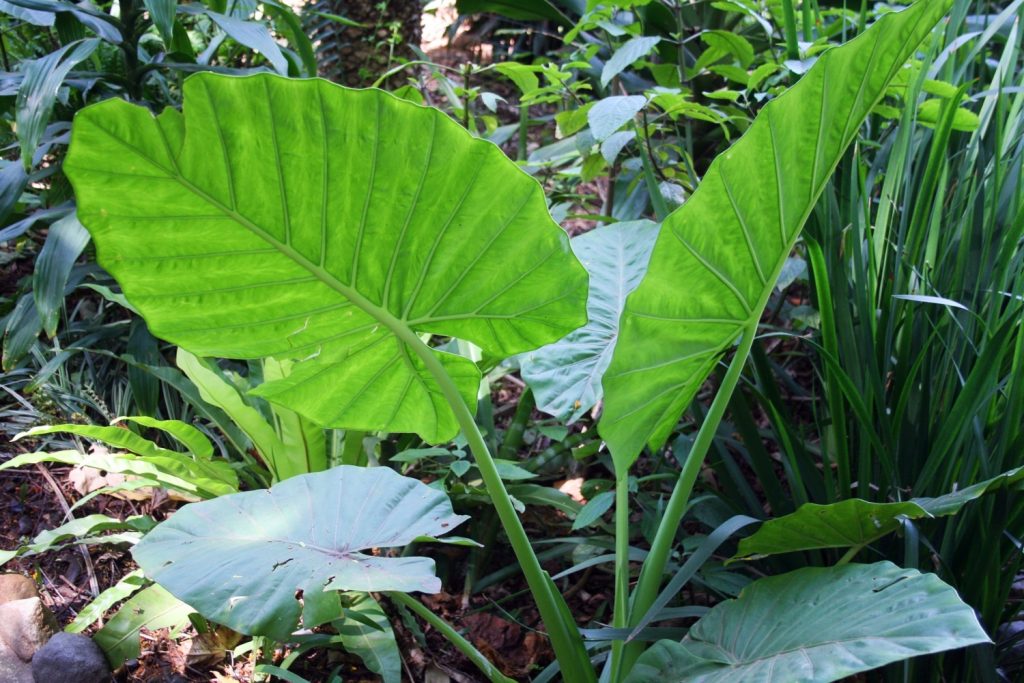
10. The problem: Feeding the plants at the wrong time
Feeding the plant at the wrong time can also cause problems.
Fertilizing elephant ears in the fall can cause wilting because the plant’s nutritional demands are much lower at the end of the growing season than they are at the start of the growing season.
Feeding the plants in winter is also a no-no. Applying fertilizers to a dormant plant means the nutrients go unabsorbed, so they sit in the soil and burn the plant’s roots.
The solution: Fertilize at the right time
Apply your first round of fertilizer at the very start of the growing season.
Apply a dose of fertilizer once a month during the growing season, to make sure your elephant ears have all of the nutrients they need to keep producing healthy foliage and strong root systems.
As fall approaches, cut the dose of fertilizer in half, and taper off completely by the start of fall.
This supports the plant’s natural growth cycle, which will prevent drooping foliage and other problems.
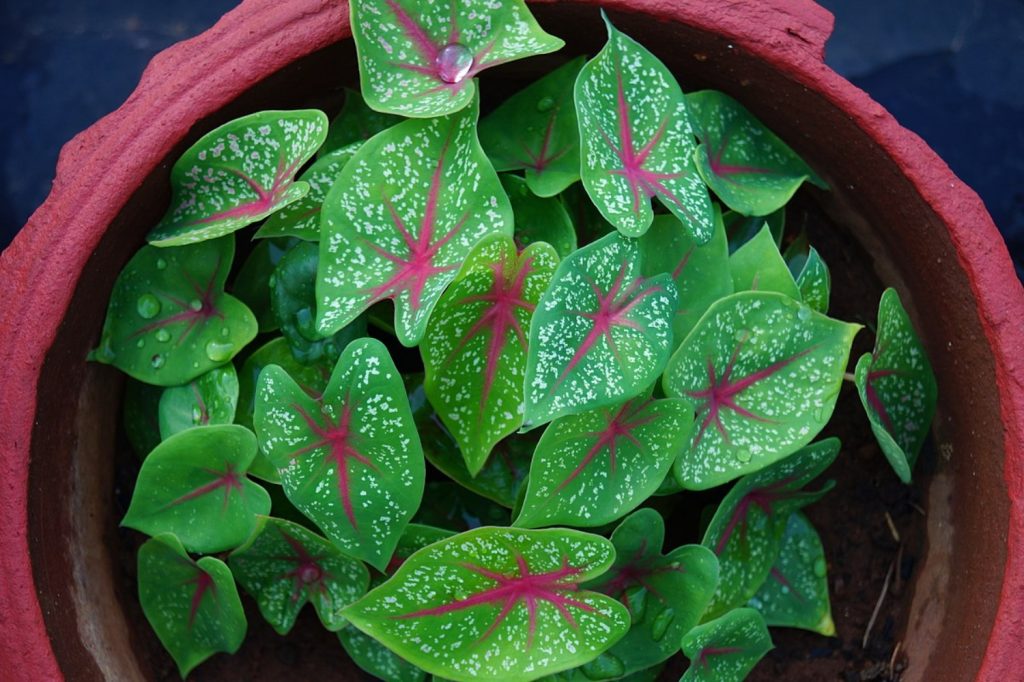
11. The problem: Insect infestations
Soft-bodied insects like caterpillars, worms, aphids, and spider mites are all too happy to make a meal of your elephant ears. And if the infestation is bad enough, it can cause the plants to droop and turn yellow.
Some insects, like thrips, are sapsuckers. They use special mouth parts to break through a plant’s leaves and feed on the energy the plant makes for itself.
Soon, the plant doesn’t have enough food to make new leaves. It doesn’t even have enough food to support the leaves it has, so it wilts and becomes discolored.
Other insects, like armyworms, make holes and chew bites out of the leaves.
Over time, this causes severe damage to the plant, hindering its ability to photosynthesize and produce food for itself.
The result, again, is wilting foliage and yellowing.
The solution: Use an insecticide
If insects are making your elephant ear plants droop, the sooner you remove them, the better off your plants will be.
Use a hose with a sprayer attachment to physically remove any insects that may be hiding in the foliage.
Once the plants have dried, apply a homemade insecticide to all parts of the leaves to kill and repel damaging insects.
In severe cases, we recommend applying diatomaceous earth. This abrasive powder penetrates the exoskeletons of soft-bodied insects, causing them to dehydrate.
Unfortunately, it can also kill beneficial bugs, so it’s best to only use diatomaceous earth as a last resort.
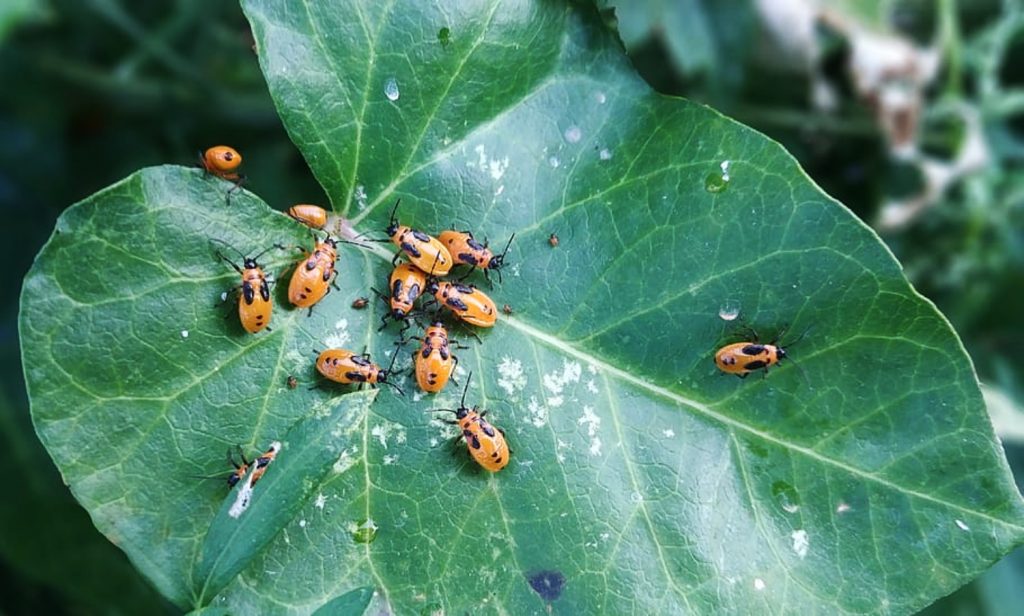
12. The problem: Rootbound
Many gardeners choose to keep their elephant ears in pots, either indoors or outdoors.
Growing your elephant ear plants in pots makes it easier to make adjustments to their routines if need be.
You can move them around to catch the light. You can meet their individual fertilizer requirements without having to worry about surrounding plants.
Pots also tend to offer these plants better drainage, which can be helpful, especially for elephant ears that have been drooping due to overwatering.
But elephant ears are fast growers. Left in the same pot for too long, the plants will become rootbound.
Rootbound plants have nowhere for their roots to grow, yet they keep growing them because, well, they need them to absorb water and nutrients.
The result is the roots follow the shape of the vessel they’re growing in, and, eventually, choke themselves out.
If your elephant ears are rootbound, you’ll find roots growing out of the drainage holes. You may also be able to move the plant around inside the pot, with the roots and dirt moving as a single mass.
The solution: Repot the plant
If your elephant ear plant has outgrown its container, it’s time to size up.
Choose a new pot for your elephant ear plant, one that is at least twice as wide and as deep as its current pot.
Fill the new pot with all-purpose potting soil amended with a heaping handful of compost.
Next, gently remove the elephant ear from its current pot. Be careful not to damage the foliage or roots during this process to avoid stressing the plant.
Place the plant in the hole, keeping the root collar even with the surrounding soil, and backfill around it.
Tamp gently to remove air pockets, then water the plant deeply until you see water coming out of the drainage holes.
Alternatively, you can transplant your rootbound elephant ear to a spot in your garden. The process is the same.
Dig a hole twice as wide and as deep as the plant’s roots. Amend the soil with compost to make it loose and fertile, then plant the elephant ear so that its root collar is level with the ground. Water the plant thoroughly when you’re done.
Once your elephant ear has enough room for its roots to spread out, the plant will perk up within a few days.
13. The problem: Transplant shock
Maybe you decided to transplant your elephant ears to a new location in your backyard. Or maybe you repotted your indoor plant to a roomier container.
If your elephant ears are drooping shortly after having been moved, that’s a sign the plant is stressed.
Other signs of transplant shock in elephant ears include brown and black spots on the foliage. The plant’s stems will also become weak and limp.
The solution: Keep the plant well-watered
The number one cause of transplant shock is dehydration.
It’s important to keep your plants well-watered in the days following transplanting to help the roots recover from the stress of being moved.
Keep your elephant ear’s soil consistently damp to the touch after moving it. Avoid letting the soil dry out during this time to ensure the plant stays hydrated.
This will prevent the plant from drooping, and enable it to start growing again as quickly as possible.
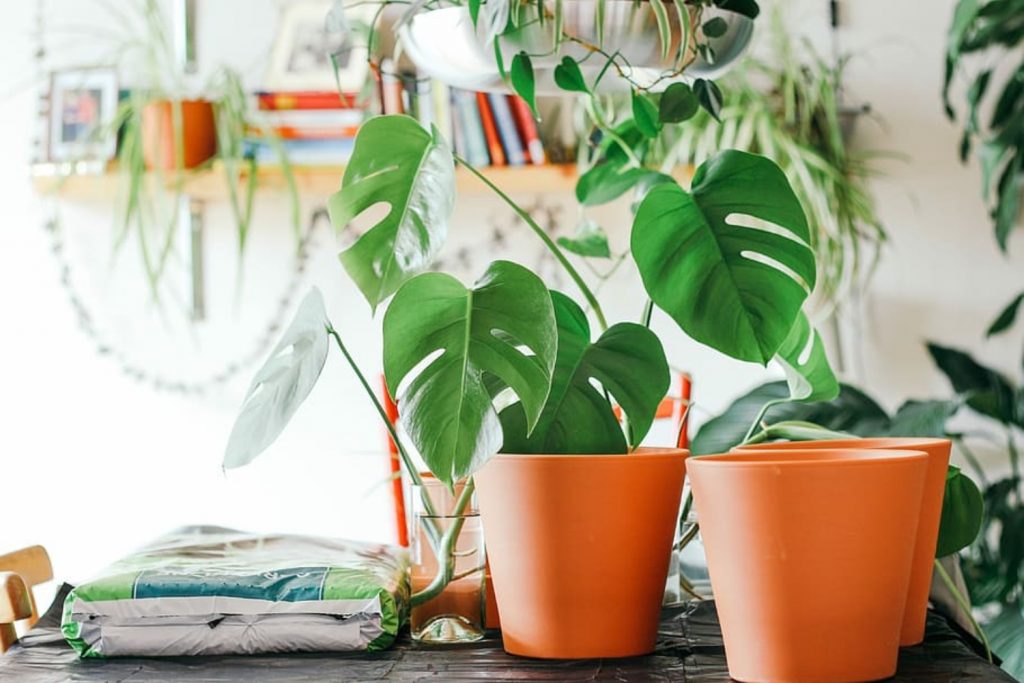
Tips for growing healthy elephant ears
Keeping your elephant ear plants from drooping is a matter of meeting their growing requirements.
By giving the plants enough light, water, and nutrients, they should grow just fine.
By paying close attention to their appearance, you can make adjustments to their care, and treat your drooping elephant ear plants before their condition worsens.
